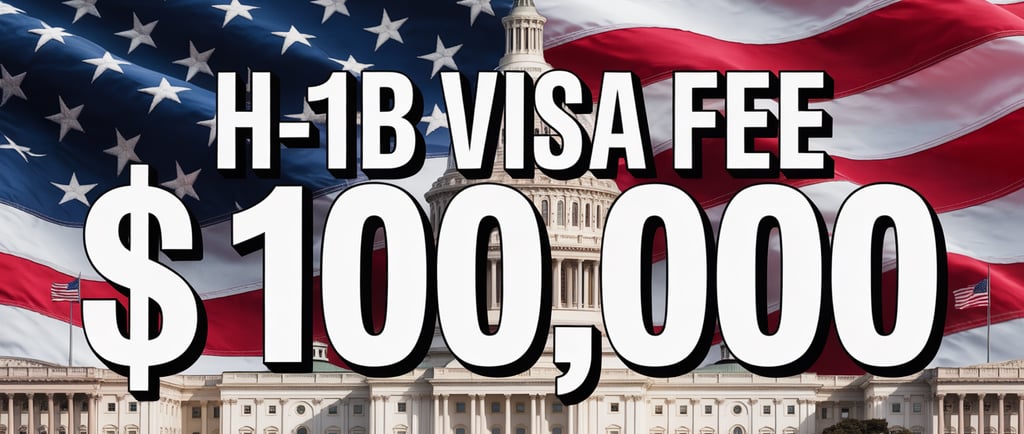New H-1B Visa Rules: $100,000 Fee Announced – What It Means for Workers and Employers
US announces new $100,000 H-1B visa fee for employers filing fresh petitions. What it means for workers, companies, and global talent in 2025–26.
TRAVEL NEWS
9/21/20253 min read


The United States has once again shaken the global immigration and job market. On September 21, 2025, President Donald Trump signed a new proclamation introducing a $100,000 one-time fee for companies filing fresh H-1B petitions. This update has already sent shockwaves across technology firms, multinational employers, and skilled workers worldwide. The rule will apply for one year, from September 21, 2025 to September 21, 2026, unless extended or overturned.
So what does this mean for employers, current visa holders, and those dreaming of working in the U.S.? Let’s break it down.
What Exactly Changed?
The H-1B program is one of the most popular pathways for skilled foreign workers, particularly in technology, healthcare, and engineering. Every year, thousands of professionals apply through a lottery system for the chance to work in the U.S.
Here’s what’s new:
The Fee: Employers must pay a $100,000 one-time fee when filing a new H-1B petition.
Effective Date: This applies to all new petitions filed from September 21, 2025 onward.
Who’s Exempt?: Current H-1B visa holders — including those renewing their visas or re-entering the U.S. — are not required to pay this fee.
Duration: The proclamation is temporary, lasting for one year, but could be extended if the administration deems it necessary.
Why Was the Rule Introduced?
According to the Trump administration, this decision is meant to:
Protect American Jobs – By making sponsorship more expensive, the hope is that employers will prioritize U.S. workers before turning to foreign hires.
Curb Abuse – Some companies have been accused of misusing the H-1B program to bring in cheaper labor and displace American employees.
Raise Wage Standards – Supporters argue the hefty fee will discourage underpayment of foreign talent and push companies to offer fair salaries.
On the other hand, critics believe this will hurt innovation, limit talent inflow, and make the U.S. less attractive compared to countries like Canada, the U.K., and Australia — which are aggressively competing for global tech talent.
Reactions Around the World
The announcement has sparked strong responses from different groups:
Employers: U.S. companies, especially in IT and engineering, rely heavily on foreign workers. While large corporations may manage the fee, smaller businesses and startups could struggle. This might discourage them from hiring skilled workers abroad.
Skilled Workers Abroad: For aspiring professionals in India, China, and beyond — who make up the majority of H-1B applicants — the news is discouraging. Many fear a significant reduction in job opportunities.
Immigration Lawyers: Legal experts predict challenges ahead, questioning whether such a massive fee can be enforced without congressional approval or a proper regulatory process.
Global Economies: Outsourcing destinations like India and the Philippines may benefit as companies shift more roles offshore instead of paying the U.S. fee.
Key Clarifications
With any major immigration change, confusion is inevitable. Here’s what has been clarified so far:
Not for Current Holders: The $100,000 fee does not apply to those who already hold an H-1B visa.
Not Annual: It’s a one-time fee, not something employers must pay every year.
Re-Entry is Safe: If you’re already an H-1B worker traveling abroad, you can return to the U.S. without triggering the new fee.
Implications for Different Groups
For Employers
Larger firms like Google, Microsoft, and Amazon may continue sponsoring H-1B workers, though at a higher cost.
Startups and smaller businesses may shy away, reducing overall demand for foreign workers.
Companies could shift hiring to offshore offices, particularly in Canada, India, or Europe, to bypass the U.S. fee.
For Current Visa Holders
Good news: Your visa status is safe. Renewals, transfers, or re-entries are unaffected.
But watch out: If you change employers and they need to file a new petition, the fee may apply.
For Future Applicants
Competition may tighten dramatically. With fewer companies willing to pay the fee, the number of job opportunities could shrink.
Workers may start looking more seriously at alternative destinations, such as Canada’s Global Talent Stream or Australia’s skilled migration program.
What Happens Next?
Legal Battles Ahead – Several immigration advocacy groups are expected to challenge the rule in court, arguing it bypasses standard legislative procedures.
Possible Exemptions – Reports suggest industries vital to U.S. interests (like healthcare and defense) may receive exemptions or reduced fees.
Election Year Politics – With the 2026 elections on the horizon, immigration will likely remain a hot political issue, and this rule may see further revisions.
Shifts in Global Talent Flows – Canada, the U.K., and Australia could see an increase in skilled immigrants as the U.S. becomes less accessible.
Final Thoughts
The $100,000 H-1B fee is one of the most dramatic changes to U.S. immigration in recent memory. While it aims to protect American jobs and wages, it may also create a chilling effect on U.S. competitiveness in the global talent market.
For workers, the message is clear: if you already hold an H-1B, your position is safe — at least for now. For new applicants, however, the road just got much tougher. Companies and professionals alike will need to adapt quickly, weighing costs, legal risks, and opportunities in other countries.
The coming months will be crucial. Court challenges, political debates, and possible exemptions could reshape how this policy plays out. Until then, one thing is certain: the H-1B visa landscape has changed, and so has the future of global talent mobility.
Categories
© 2025. All rights reserved.
Quick Links
Save on flights & stays from the UAE.


